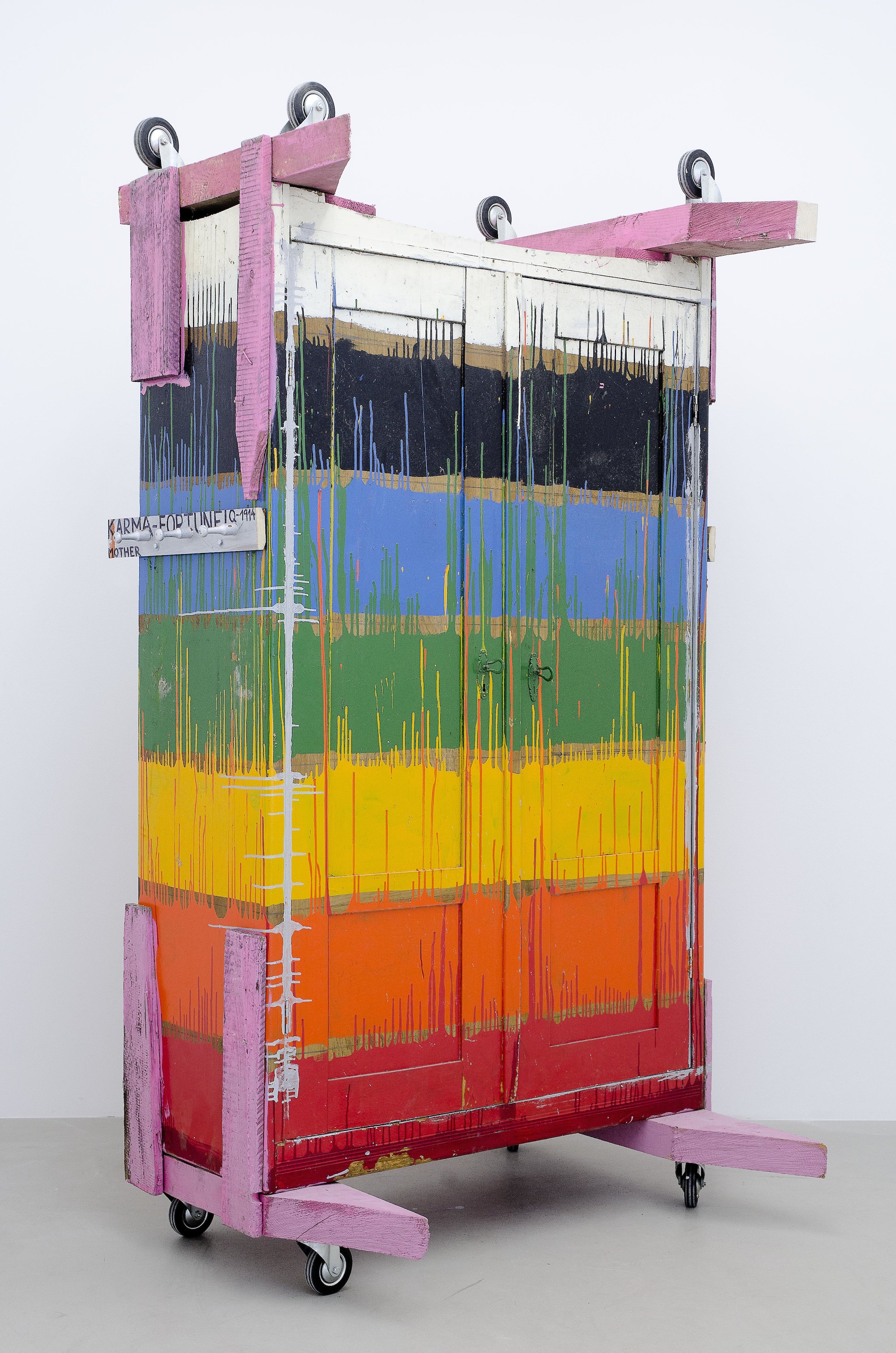Characterstics of System SF: Colors and Dimensions
Main Hall

The Wardrobe in the 7 Chakra Colors / Skriňa vo farbách 7 čakier, ca. 1995
Found object, wood, paint
250 × 120 × 135cm
Courtesy Peter Petrička, Bratislava
Throughout his life Stano Filko took an intensive interest in different areas of knowledge such as far-eastern philosophy, religion, astronomy, and metaphysics, but also with texts from the Western philosophy of Plato, Hume, Kant, Hegel, and Wittgenstein. Filko was particularly interested in holistic connections between phenomena, which is something we can also see in his art. With his System SF Filko developed an overarching order that gave the colors he used in his works different meanings and attributed them to chakras and dimensions.
System SF is an artistic cosmos that came over the years to include all the areas of Filko’s life. He untiringly produced works in his studio, whereby the logic of his system led to new spatial and symbolic connections between everyday objects. Filko began this system with three colors, and then from the mid-1980s to the late 1990s it had seven, and thereafter the number increased to twelve.
The following artworks illustrate the progress in developing the System SF and its differentiations. Right at the beginning of the exhibition, in the main hall, three grid-like sculptures made of painted wooden planks recall the early three-color system. The abstract expression of this group with the figurative title Three Women (3.4.5.D.) (1995) recalls the cubist beginnings of abstract art. Both Filko’s System SF and also the modernist avant-gardes have claims to universality, and here Filko attempts to make these very specific spatially and to connect them with the demands of reality. Finally the three women’s abstract physical nature like a dryadic ballet also recalls theater and performance, while the ground-level rollers suggest movements and transformation.
The work EGO-Gemini-Reincarnation (5.4.3.D.) (1995) also shows the three original colors of the system. The three colors are each applied to a large wooden surface, with intermediate smaller wooden boards in black, which is the color of the ego in Filko’s system. These painted boards include cut out shapes that form a rough representation of the letters E‑G-O in reverse order. The ego in Filko’s artistic system stands as a backdrop or pattern across the dimensions, as the unfolding of the self and the basis of the world of human experience.
In the main hall there are also several object from the seven-chakra phase of this system. The sculpture The Wardrobe in the 7 Chakra Colors (1995) appears as a highly concentrated block. The object is painted in rough stripes in the seven colors, with the upside-down drips giving it a dynamic quality that is further emphasized by the rollers on the bottom and top. The original function of the wardrobe as a piece of furniture for storing clothes and everyday objects also indicates the archiving function of System SF, which Filko used to categorize his work. The colors also structure the rooms of his studio, which he himself often referred to as a store.
This storage and orientation function of the system is also continued with several drawers and boxes painted with colorful characters, spread around the room and demonstrating the system’s basic colors and dimensions.
The two sculptural ladders 7 Chakra Colors Ladder (1995) and 12 Chakra Ladder (2005) were originally an integrative part of Filko’s studio. By linking rungs of the ladders with colors, Filko accorded each color’s chakra a firm place in the system. At the same time the symbol of the triangle or the pyramid associated with the ladders represents an idealized form of the universe in Filko’s cosmic worldview. The colored rungs integrate invisible space by means of the spaces between them and they also raise System SF onto a cosmic and conceptual level.
The color axes of the system spread horizontally through the rooms, in the form of painted wooden sticks leaning on the walls, transforming the whole space into a field of different forces.
From the series EGO / Zo série EGO, ca. 1995
Found materials, paint, cardboard,
152 x 12 cm
Seven Chakra Colors / Sedem farieb čakier, ca. 1995
Found Material, acrylic, wood
430 x 11 x 2 cm
Three Women (3.4.5.D.) / Tri ženy (3.4.5.D.), ca. 1995
Wood, painting
3 objects, each 225 x 222 x 227 cm
EGO-Gemini-Reincarnation (5.4.3.D.) / EGO-Blíženci-Reinkarnácia, ca. 1995
Paint, wood
3 parts, each 200 x 150 x 40 cm
The Wardrobe in the 7 Chakra Colors / Skriňa vo farbách 7 čakier, ca. 1995
Found object, wood, paint
250 × 120 × 135 cm
Courtesy Peter Petrička, Bratislava
5.4.3.D, ca. 2000
Found objects, acrylic, wood
3 Objekte / 3 objects, 42 x 52 x 11 cm, 42 x 52 x 11 cm, 56 x 52 x 11 cm
7 Chakra Colors Ladder / Rebrík vo farbách 7 čakier, ca. 1995
Found objects, acrylic, metal
188 cm x 94 x 41 cm
From the series 12 Chakra Ladders / Zo série Rebríky vo farbách 12-tich čakier, ca. 2005
Found object, acrylic, wood
400 x 133 x 80 cm
Wooden Poles in Chakra Colors / Drevené tyče vo farbách čakier, ca. 2005
Paint, wood
9 pieces, each 400 cm long
Central Brain / Centrálny mozog, ca. 2000
Found objects, fabric, plastic cord, wire
70 x 55 x 55 cm
All works if not otherwise stated Courtesy Linea Collection, Bratislava; Layr, Vienna